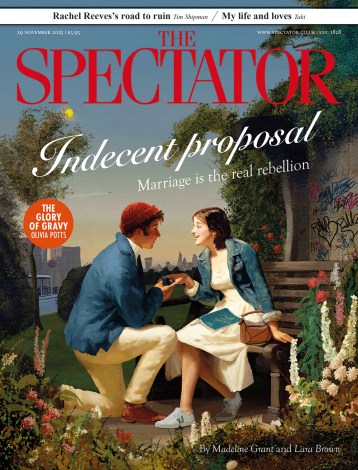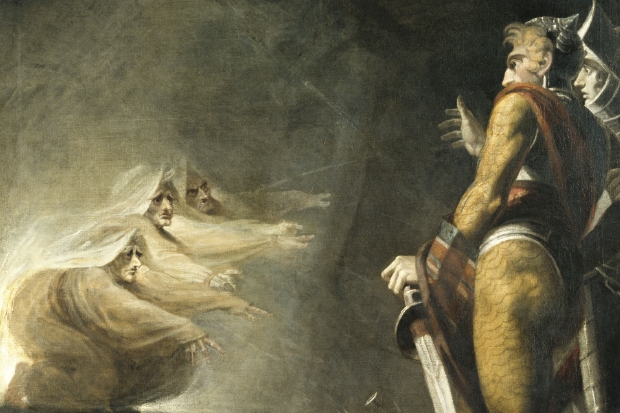There was a genteel brouhaha last year — leaders in the Times, letters to the Telegraph, tutting in the galleries — about the British Museum’s decision to play Pan-pipe music into its exhibition Celts: Art and Identity. Did the gold torcs and coin hoards sparkle the more for the looped song of Pan-pipes? Not really, and it didn’t half annoy visitors.
Not put off by the British Museum’s Pan-pipe complaints, Compton Verney in Warwickshire has been at the jukebox for its Shakespeare in Art: Tempests, Tyrants and Tragedy. The exhibition takes Caliban’s ‘the isle is full of noises’ literally, giving us wishy-washy wave sounds and shiver-me-timbers deck-creaking for The Tempest, recordings of Ophelia’s mad, mournful singing and Gertrude’s ‘there is a willow grows’ speech for Hamlet, chirruping birds for A Midsummer Night’s Dream and plingy-plangent lute music for the history plays. In one unfortunate spot you hear birds, Gertrude and lute all together. In the ambient-music business this is known as ‘sound bleed’.
These competing noises do great disservice to the art. If Henry Fuseli is any good at theatrical painting — and at his best he is the most marvellous old 18th-century ham — he doesn’t need musical accompaniment, nor a special lighting machine spinning misty ‘blasted heath’ effects around the gallery. While Fuseli may not be a perfect technician — close-up his paintings have a rapid, unfinished quality — he knew how to do drama. His tight claustrophobic portrait of the ‘The Three Witches’ (1782) has the oppressive closeness of a nightmare, while his ‘Macbeth, Banquo and Witches on the Heath’ (1794) imagines the returning army as bleached, spectral and more dead than alive. The two commanders are tense and battle-shattered, stiffened to bronze and stone in their fright at the witches.
The exhibition, staged to coincide with the 400th anniversary of Shakespeare’s death, is billed as presenting ‘artistic responses’ to his most popular plays. Some of it is artistic responses, some of it backstage ephemera from memorable productions. All of it’s a muddle.
There are Fuseli’s history paintings and John Singer Sargent’s ‘Ellen Terry as Lady Macbeth’ (1889), terrible and gimlet-eyed in her emerald sleeves. There are contemporary responses from installation artists Davy and Kristin McGuire, whose ‘Ophelia’s Ghost’ (2014) projects a holographic drowned woman into a bath-coffin of water, and photographer Tom Hunter who recasts A Midsummer Night’s Dream (2010) in Hackney bars and strip clubs. Without the captions it would take some imaginative leap to know that a samba dancer snoozing on the baize of a snooker table was embodying ‘There sleeps Titania’.
There is a brick wall with a chink to blink through with thine eye, a poem by Kate Tempest, recited, mercifully, through headphones, and rehearsal photographs, set models, costume designs and a demonstration of the stage trick Pepper’s ghost. All the while, the lute is plucked and the birds twitter.
The rest, happily, is silence. Across the stairwell, an admirably clear-sighted companion exhibition, Boydell’s Vision: The Shakespeare Gallery in the 18th Century, examines the efforts of the print entrepreneur John Boydell to establish a temple to Shakespeare on Pall Mall with scenes from his plays painted by the artists of the day. It was vastly expensive — Joshua Reynolds was given £500 for his first commission — and, in the end, vastly ruinous.
But the enterprise was promising to begin with. The gallery opened in May 1789 with 34 paintings by 18 artists; 20,000 visitors attended and 6,600 catalogues were sold. All the paintings were engraved and available to buy as prints.
There are fine examples here, among them Fuseli’s ‘Titania and her melancholy Bottom’ (1790) and Joseph Wright of Derby’s scene from The Tempest, engraved by Robert Thew (1790–92). Miranda wraps her arm around the neck of the absurdly dressed Ferdinand and murmurs: ‘Oh brave new world that has such trousers in it.’
There is an inspired digital recreation of the Shakespeare Gallery as it was hung, mapped by Professor Janine Barchas of the University of Texas, but otherwise there is no whizz-bang noise and nonsense. It is a small show, but superb.
Compton Verney is also toasting the 300th anniversary of the birth of Lancelot ‘Capability’ Brown, whose serpentine lake and paths wend through the park. Leave yourself time for a walk. It is blessedly quiet among the ashes and oaks.







Comments